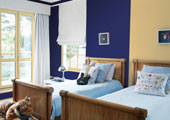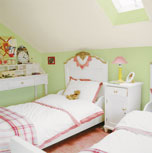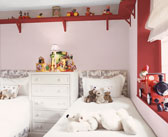You don’t have to be a Jon-and-Kate-plus-eight-family to have siblings share a bedroom. Nowadays, it’s a matter of economics and practicality for brothers or sisters to bunk together.
One of the beauties of decorating with paint is that it’s so easy to change out as kids grow and their tastes evolve. Childhood development experts agree that sharing a room offers early life lessons in learning to cooperate. Kids learn, as well, from having a say in how the room is decorated. Helping to choose the paint color, for instance, is a wonderful way for a youngster to gain self-confidence and feel empowered.
“Think back to your own childhood and the impact color had in helping to define your world,” said Sharon Grech, Benjamin Moore color expert and mother of two. “You probably had a favorite color shirt, or at least a favorite crayon color. And, certainly you chose the lollipop or candy by color, not by flavor. So, allowing a child to choose his or her own room color is an experience that helps foster individuality while nurturing creative expression.” Grech advised that if, in the sibling share situation, it’s a split decision on the colors, there’s always a middle ground to be found. For instance, if beds are placed side by side, let Susie have her color choice on the wall nearest her bed, and paint Cindy’s color pick on that opposite wall. If the colors are compatible or even strong contrasts, think about creating a stripe pattern, even possibly adding in a third color that’s your parental preference. Or, let one child choose the wall color, the other the trims. Another truly Solomon solution is to literally create a great divide, with Jason’s side of the room painted in his hue, Mark’s in his for a duo-tone, duo-zone space. When it comes to bunk bed furnishings, just think horizontal and paint the upper half of the room one color, the bottom half another.
Grech advised that if, in the sibling share situation, it’s a split decision on the colors, there’s always a middle ground to be found. For instance, if beds are placed side by side, let Susie have her color choice on the wall nearest her bed, and paint Cindy’s color pick on that opposite wall. If the colors are compatible or even strong contrasts, think about creating a stripe pattern, even possibly adding in a third color that’s your parental preference. Or, let one child choose the wall color, the other the trims. Another truly Solomon solution is to literally create a great divide, with Jason’s side of the room painted in his hue, Mark’s in his for a duo-tone, duo-zone space. When it comes to bunk bed furnishings, just think horizontal and paint the upper half of the room one color, the bottom half another.
One choice that can’t be left to the kids is which paint is safest to use. “Ideally, you should be shopping for paint with minimal or zero Volatile Organic Compounds (VOCs)”, said Grech. “Without getting too scientific, VOCs are groups of chemicals often found in many household products, including conventional paints, nail polish and other building and decorating materials. Exposure to them can pose risks.”
According to Grech, when shopping for paint, the number one question you ask should be, “Is this genuinely zero-VOC paint?” Make sure to also find out whether there are VOCs in the colorant - the tint that’s mixed in to give you your color choice.
“What so many consumers are unaware of,” she said, “is that the base paint may be zero-VOC, but the colorant has VOCs, and so they mistakenly think they’re walking out of the store with a zero-VOC paint. You just really have to be cautious, curious and conscious about what you’re purchasing.”
With its colorants free of VOCs, Benjamin Moore Natura paint is available in all of the 1,800-plus colors that the company offers, plus it can be custom-matched. So, how can any child, let alone an adult, decide from such an assortment? Grech and other Benjamin Moore color experts put together a few possible combinations for sibling shares. For instance, an attic space in one family’s home was converted into a charming and cozy bedroom for two young sisters. The slanted ceiling that follows the roofline of the house was punctuated with a skylight, adding even more character to the space. One child is a loyal vanilla fan, the other more adventuresome in tastes, so the color choices were Benjamin Moore’s Easter Lily OC 126, a white with the palest tint of green, and Potpourri Green 2029-50, a pleasing yellow-green. Easter Lily was applied to the ceiling, Potpourri Green to the wall and also used to line the skylight casing, distinctively framing the heavenly view. A room shared by two brothers immediately telegraphs their individual personalities, with one side of the wall painted Benjamin Moore’s Starry Night Blue 2067-20 and the other treated to a shade on the other end of the color spectrum, Citrine AF 370. The unexpected color combination actually also works to define each child’s personal space and suggests a sporty, team-like spirit.
For instance, an attic space in one family’s home was converted into a charming and cozy bedroom for two young sisters. The slanted ceiling that follows the roofline of the house was punctuated with a skylight, adding even more character to the space. One child is a loyal vanilla fan, the other more adventuresome in tastes, so the color choices were Benjamin Moore’s Easter Lily OC 126, a white with the palest tint of green, and Potpourri Green 2029-50, a pleasing yellow-green. Easter Lily was applied to the ceiling, Potpourri Green to the wall and also used to line the skylight casing, distinctively framing the heavenly view. A room shared by two brothers immediately telegraphs their individual personalities, with one side of the wall painted Benjamin Moore’s Starry Night Blue 2067-20 and the other treated to a shade on the other end of the color spectrum, Citrine AF 370. The unexpected color combination actually also works to define each child’s personal space and suggests a sporty, team-like spirit.
“Remember, one of the beauties of decorating with paint is that it’s so easy to change out as kids grow and their tastes evolve,” said Grech. Take the family, for example, who knew from the start that its twins would share a room from cradle to college. It was planned that the simple design of the space would mature with them, receiving a paint makeover every three or four years with some minor tweaks, as well, to the furnishings. In its current state - with toile headboards and dust ruffles, a menagerie of teddy bears, and a collection of carved wood pull-toys - it’s ideal for the eight-year-old denizens as they segue to pre-teen life. The wall color currently is Benjamin Moore’s creamy Proposal AF 260 with Raspberry Truffle 2080-10 trimming the window and applied to a display shelf that hugs the room close to the ceiling. It’s a crisp, cheery look, but it’s a sure bet to undergo a color transformation in another couple of years as the stuffed animals and toys are packed away to make room for issues of Teen Vogue and Seventeen, makeup mirrors, iPod docks and jewelry boxes.
Take the family, for example, who knew from the start that its twins would share a room from cradle to college. It was planned that the simple design of the space would mature with them, receiving a paint makeover every three or four years with some minor tweaks, as well, to the furnishings. In its current state - with toile headboards and dust ruffles, a menagerie of teddy bears, and a collection of carved wood pull-toys - it’s ideal for the eight-year-old denizens as they segue to pre-teen life. The wall color currently is Benjamin Moore’s creamy Proposal AF 260 with Raspberry Truffle 2080-10 trimming the window and applied to a display shelf that hugs the room close to the ceiling. It’s a crisp, cheery look, but it’s a sure bet to undergo a color transformation in another couple of years as the stuffed animals and toys are packed away to make room for issues of Teen Vogue and Seventeen, makeup mirrors, iPod docks and jewelry boxes.
Benjamin Moore & Co. has been a longstanding steward of the environment with a relentless commitment to sustainable manufacturing practices plus the ongoing development of the most eco-responsible formulations possible. Visit www.benjaminmoore.com to explore other possible color combinations not only for kids’ rooms, but for your entire home using the Personal Color Viewer.
Calgary’s Child Magazine © 2024 Calgary’s Child